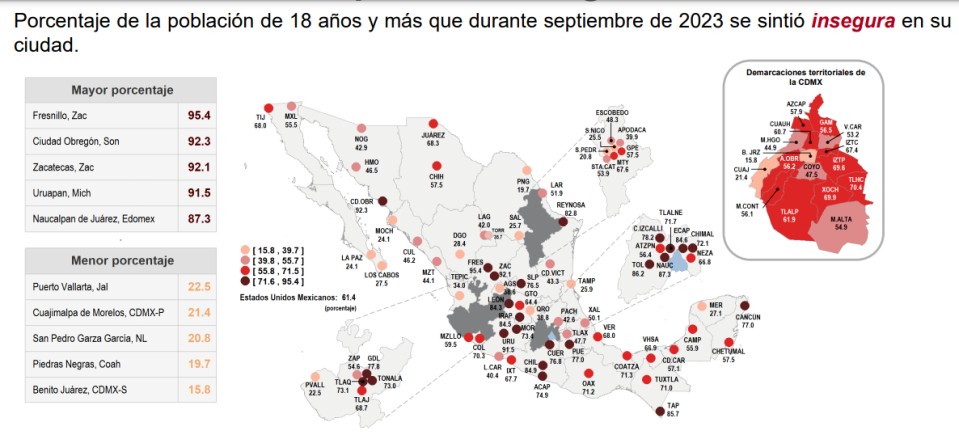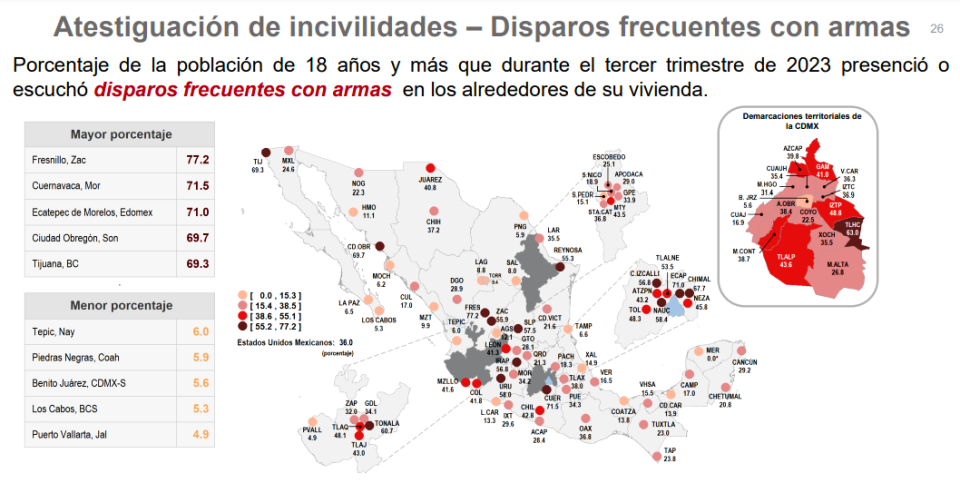Most Mexicans feel unsafe, especially in drug cartel areas, survey says

EL PASO, Texas (Border Report) – As drug cartel activity spreads throughout Mexico, so does the fear ordinary residents feel of falling prey to crime, a newly released Mexican government study shows.
Almost seven out of 10 adult residents of the border cities of Tijuana and Juarez – and 83 percent of those who live in Reynosa – feel unsafe, according to the “Encuesta de Seguridad Publica Urbana” (Urban Public Safety Survey) published Oct. 19 by the National Institute of Information, Statistics and Geography (INEGI).
The fear is greatest in the state of Zacatecas, where warring cartels have hung bodies from bridges and stuffed them inside cars 10 at a time on the street in recent years. The survey says 95.4 percent of the residents of Fresnillo and 92.1 percent of those living in the state capital of Zacatecas feel unsafe.
Fear also runs high (92.2%) in Ciudad Obregon, Sonora, where dozens of people are missing and a group of grieving mothers often spend the weekends digging in abandoned backyards, looking for bodies. In Uruapan, Michoacan, where cartels reportedly have placed quotas on lime growers and merchants, the fear index is at 91.5%.

Overall, 61.4% of all Mexicans over 18 surveyed stated they feel unsafe in their cities. Other than cartels, a simple trip to the ATM and violence from drunks and individuals high on drugs stresses Mexico’s urban dwellers, the survey shows.
The INEGI survey also reveals that in a country where firearms sales are strictly controlled and few permits are issued, 36% of the population has witnessed or heard shootings near their homes in the past three months.
In Juarez, 40.8% of adults over 18 have witnessed or heard “frequent gunshots around their homes” between July and September, according to INEGI. The percentage is even higher in Tijuana (69.3%), Reynosa (55.3%) and Chilpancingo (48.8%).

Chilpancingo is the state capital of Guerrero, where seven decapitated bodies were left in front of a church in June. In August, a drug cartel dropped more than 30 bombs from drones just 30 miles northwest of Chilpancingo.
“It is always. I always see assaults. On this corner, they once found a guy dismembered,” an elderly resident of the Aztecas neighborhood in Juarez told Border Report. “In recent years, our neighborhood has been a disaster. It’s ugly.”
The resident, who would not allow his face to be shown on camera, said residents avoid trouble by sticking to their daily routines and keeping their mouths shut. “We don’t trust the law. At all. They’re worse. I’ve been in this neighborhood since young and it’s best to be leery (of the police). Many times you’re going about your business and they get you for any little thing,” the resident said.
Another Los Aztecas resident said he tries to avoid going out when he doesn’t have to. The man in his 30s said he recently witnessed a shooting. “You can’t even go out anymore,” he said.
(Juarez freelance photojournalist Angel Cervantes contributed to this report.)
For the latest news, weather, sports, and streaming video, head to FOX 5 San Diego.

